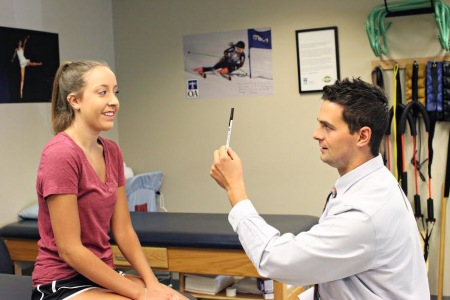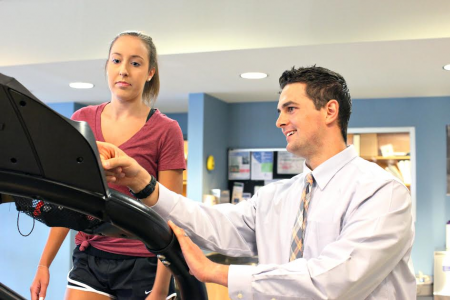A concussion is a mild traumatic brain injury, most often caused by a blow to the head. Concussions are usually not life-threatening. Even so, the effects can be serious.
Here’s what can happen when your head takes a hit. Your brain slams against the inside of your skull and then ricochets and slams against the opposite side. The movement can cause chemical changes and damage brain cells. Some people lose consciousness but most don’t. And most people also recover quickly and completely.
The problem is that diagnosing a concussion isn’t always easy because the signs are often more functional than structural. That means they don’t show up on an MRI or a CT scan and instead, the person just doesn’t feel right. Some signs show up immediately, but others may not be noticed for days or even months.
Bobby Cochrane works with people who have had a concussion and are still dealing with some lingering issues — it’s often called post-concussion syndrome. He’s a physical therapist at OA Centers for Orthopaedics in Portland, Maine and works closely with all of OA’s sports medicine physicians, including Dr. William Heinz, who specializes in diagnosing and treating sports-related concussions.
The vestibular system
So, how can a physical therapist help someone with a mild traumatic brain injury? Bobby says it’s a three-pronged approach. The first is to work on the person’s vestibular system. Located in our ears, it helps us know where we are in space.
“The example I like to give,” says Bobby, “is to imagine you’re in the passenger seat of a corvette and Mario Andretti is driving and you’re blindfolded. You can’t see trees going by, you can’t see other cars going by, you can’t see buildings going by and it’s not Fred Flintstone’s car so you can’t tell how fast you’re going by how fast your feet are going.
You still know when Mario Andretti hits the gas, when he hits the brake, when he turns and when he goes up or down a hill. That’s all your vestibular system. It’s telling you where you’re going and it detects acceleration and changes in direction.”
A concussion can damage the vestibular system and cause dizziness or balance issues. Most of the time, Bobby says he focuses on the vestibular ocular reflex. Simply put, that’s the coordination between eye and head movements. “Imagine that your head is out in front of you and you’re looking at the tip of your finger,” he says. “If you turn your head to the left, your eyes go right. If I turn my head ten degrees to the left, my eyes have to turn 10 degrees to the right in order to track right.”
When the system isn’t doing its job, some people will try to stop moving their head to avoid the symptoms. Bobby gives them special head movement exercises to do what, in a way, forces the issue. The goal is to habituate the brain or get it used to one ear not working the same as the other. He starts off slowly and gradually increases the pace of the exercises.
Pain in the neck
Another thing that people with concussions may deal with is pain — only it’s not in their heads, it’s in their necks. Bobby works on their posture and tries to get things moving again, the way they’re supposed to be moving. “That way,” he say, “dizziness and headaches originating from the neck are not compounding their symptoms coming from a concussion.”
Heart rate
And finally, he tries to get the blood flowing and to increase a person’s heart rate. After a concussion, many people experience an energy gap — they find they don’t have the same level of stamina. Even simple tasks may be exhausting. “If you get someone with post-concussion syndrome,” says Bobby, “and you have them hop on the treadmill they’re going to get symptoms. It’s because their brain is requiring more energy but they’re not getting it.”
Following what is known as the Buffalo protocol, he starts people out on the treadmill at a slow pace on a flat track. He then gradually increases the incline. “The idea,” he explains, “is that we increase their heart rate incrementally. I want to know what their heart rate is when they start to get symptoms. Let’s say at 120 beats per minute they get a headache or get nauseous or dizzy, I know their ceiling heart rate is 120 beats per minute. “According to the Buffalo protocol, I will have them exercise at 80 percent of that.”
The person should be able to exercise at 80 percent at least a half hour each day without any symptoms. “What happens over time is their body accommodates to that increased heart rate,” says Bobby. “The next time you test them, the next week, their ceiling heart rate goes up. Instead of 120, it’s now 137 and so their new target heart rate is going up. They can do more and more work as they get better.”
Eighty to 90 percent of all concussions resolve on their own in seven to 10 days. That’s without any intervention. The most effective treatment is usually rest because it helps the brain heal.
The people Bobby treats are the 10 to 20 percent who don’t get better. Most of his patients are referred by a sports medicine specialist. “Usually, after a concussion, there is a restriction in either work or in school that then gets lifted as the patient improves,” he says. “If there’s not a whole lot of improvement in symptoms within 10 days or two weeks or after the seven to 10 day period, that’s when they come see us.”




Leave A Comment